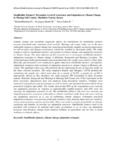Smallholder Farmers’ Perception, Level of Awareness and Adaptation to Climate Change in Masinga Sub County, Machakos County, Kenya

View/
Date
2022Author
Kimoni, Marrietar N.
Nzyengya, Daniel M.
Nzeve, Julius K.
Metadata
Show full item recordAbstract
Climate change and variability negatively affects the contribution by smallholder farmers
towards household and community food security. Masinga sub-county being one of the most
vulnerable regions to climate change has experienced unreliable rainfall, increased temperature
as well as pests and disease occurrences which has resulted to decreased yields. The study
sought to analyze smallholder farmers’ perceptions to climate change, and adaptation strategies
to climate change. The main objective of this research was to investigate smallholder farmers’
adaptation strategies to climate change in Kithyoko, Kangonde and Masinga Locations. The
closed and open-ended questionnaires and structured interview guides were used to collect data.
Basically, questionnaires were employed to gather data from smallholder farmers’ perceptions,
adaptations strategies and constrains of adaptation practices to climate change in Masinga subcounty. The qualitative data was collected from the key informants by use of interview guides in
the three selected locations. The study employed Krejcie and Morgan’s (1970) formula for
calculating the sample size, which states that, for a sample of 36,251, a sample size of 300 is
appropriate. Based on this, therefore, the study targeted 300 households in three locations
namely: Kithyoko, Kangonde and Masinga in Masinga Sub-County and 30 key informants in the
three locations). Quantitative data was analyzed using descriptive statistics. Findings were
expressed in frequencies and percentages as well as means and standard deviation before being
presented in figures and tables. The results showed that 90% of the respondents were carrying
out adaptation practices in response to unpredictable rainfall patterns and 10% were not
carrying out adaptation practices at all. The smallholder farmers who were not carrying out
adaptation practices were more vulnerable to climatic variations unlike those who were carrying
out adaptation practices as a way of cushioning climate changes. Commonly practiced
adaptation strategies were growing of drought resistant crops, planting improved crop varieties,
conservation practices and use of pesticides. There was need to sensitize households on climatic
variations and benefits of carrying out adaptation practices. Smallholder farmers need to be
provided with resources by national and county government so as to carry out adaptation
practices and therefore change from outdated methods of agriculture and be able to build
resilience to climatic effects.
